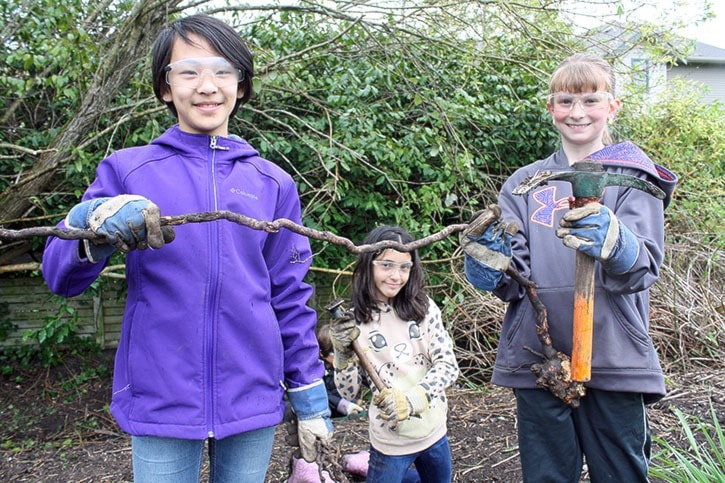Four hundred students of Royal Oak middle school were on their hands and knees to help repair a forgotten waterway last week.
What they’re uncovering one stretch at a time is the mistreated Mahon Brook, where water trickles underground more than it does above.
But make no mistake, the Colquitz River tributary is a valuable asset to the Colquitz Watershed. The two-day work party was the latest part of the school’s 150th anniversary celebration.
“For a while there, water running through your property seemed to be an inconvenience,” says volunteer Mary Haig-Brown, who’s been a part of Royal Oak for 40 years. “People threw dirt on it, hoped they could cover it up, but of course we know you can never cover it up and now we know how important it is.”
While Mahon Brook isn’t much to look at – its dry stretches mislead its importance because it’s been covered in earth – the class were seeding it with 400 salmon fry at Brydon Park, just a kilometre downstream. The students raised the fry egg-stage using an aquarium that sits in the halls of the Royal Oak middle school.
“Salmon are resilient and we’re learning that just because we’ve put culverts underground, doesn’t mean they won’t swim up them,” Haig-Brown said. “There’s been a spotting of a salmon trying to jump through the grate into Rithet’s Bog. The only way we know is because someone was there to actually see it.”
Haig-Brown’s children attended Royal Oak, she taught there, and now she has two grandchildren there. She was volunteering at the Royal Oak work party with Peninsula Streams Society volunteers, who brought their Creatures of Habitat initiative. The initiative was designed for Grade 6 students and has been a success at Bayside and Colquitz middle schools.
“Every student from Grades 6 and 7 put in time for this,” said teacher Del Morgan, who led her Grade 6 and 7 class through the mud. “We’ve hauled out truckload after truckload of invasive species, including English Ivy stumps as thick as trees and poisonous hemlock (which adults handled). I can’t put a number on the amount of plants, but it’s been a lot of work.”
The cleared area is on the western edge of the Royal Oak school ground, where Mahon Brook acts as a border for the property. In recent years, the brook had disappeared behind a wall of brush until a Saanich Parks and Recreation crew started clearing it in the fall.
“It’s the (Himalayan) blackberry root balls that are a lot of work,” said Grade 6 student Taryn Rosales. “They take a long time to get out, they keep running underneath the ground.”
Blackberry root balls were the trophies of the day, earning “oohs” and “ahhs” from students and adults alike. Finding the rootball is the only way to remove the blackberry completely.
The students were also careful to work around any native species, such as trailing blackberries. Sadly, an area that was cleared and replanted by Saanich in the fall has had some of its coveted native plants removed from within the fenced-off area, said Haig-Brown.
Peninsula Streams, The Compost Education Centre, LifeCycles Project Society and other groups led related workshops inside the school.
Students who participated at Bayside removed invasive species from the school grounds, while others did the same at the nearby Gowland Tod Park. Colquitz students focused on Colquitz River Park.
reporter@saanichnews.com
